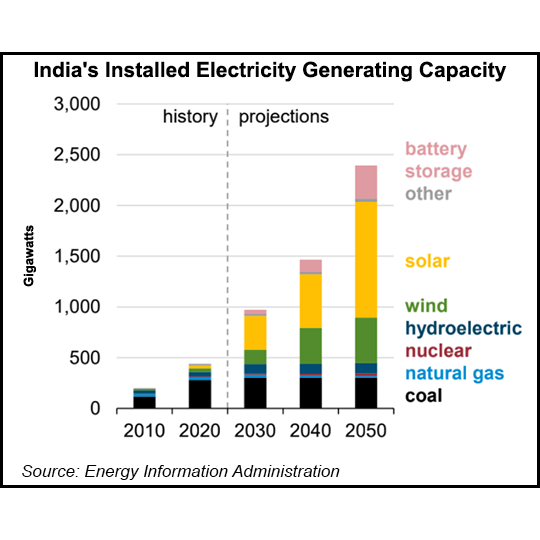International | LNG | LNG Insight | NGI All News Access
Sanctioned Russia Looks to Secure More Supply Deals With Natural Gas-Hungry India
Despite Western sanctions against Russia, the country may become closer energy partners with India after the two governments recently discussed the potential for further oil and gas deals.

Russian Deputy Prime Minister Alexander Novak and India’s Minister of Petroleum and Natural Gas Hardeep Singh Puri talked last week about current and potential joint energy collaborations between the two countries.
Novak said Russia’s oil and petroleum product exports to India have approached $1 billion, adding that there are “clear opportunities” to increase the figure.
India has not condemned Russia’s invasion of Ukraine. It has also abstained from voting against Russia at the United Nations. Since China and India have remained “neutral” over the crisis, both countries are seen potentially buying Russian liquefied natural gas at discounted prices.
Europe, Russia’s largest gas consumer, has set forth a plan to gain independence from Russian natural gas by 2030. Russia has also strengthened its energy exports to China in recent years.
India’s Oil and Natural Gas Corp. affiliate ONGC holds a 26% stake in Russia’s Vankor oil and gas field in Eastern Siberia, and a 20% stake in the Sakhalin-1 liquefied natural gas (LNG) project. ExxonMobil and Shell plc have withdrawn from the Sakhalin projects, opening an opportunity for ONGC to increase its stake in Sakhalin 1, or invest in the proposed Sakhalin 2.
LNG imports currently account for about 50% of India’s gas consumption since domestic natural gas production is unable to meet increasing demand, according to government data. India has also been a target for LNG export growth in North America given increasing demand there. The United States shipped 57.5 cargoes to India last year, according to NGI data.
India has six operating terminals with 42.5 million metric tons/year (mmty) of regasification capacity. A further 17 mmty of capacity is expected to be added within the next two years. The government has set a target to expand import capacity to 70 mmty by 2030, and 100 mmty by 2040, according to India’s oil and gas ministry.
But half of India’s six existing terminals are operating at less than 65% of capacity due to insufficient downstream takeaway capacity. The government has allocated billions of dollars to update India’s gas infrastructure, including building new distribution networks and LNG terminals to improve utilization rates.
India’s LNG imports were lower for the first two months of 2022, according to Kpler data. January and February imports were 3.21 million tons (Mt), compared to 4.06 Mt imported in January and February 2021.
Over 85% of imported LNG is under long-term contracts, according to India-based ratings agency Crisil. Buyers in the country are extraordinarily sensitive to price swings in the spot market given the insulation they have from high prices under those long-term deals. They tend to avoid costly spot purchases of the super-chilled fuel, particularly at the record-high prices seen this year.
Petronet Ltd. has two long-term supply contracts with Qatar for 7.5 mmty and 1 mmty. State-controlled gas distributor Gail Ltd. has a 20-year deal with Gazprom PJSC for 2.5 mmty, which started in 2018. Gail also has a 20-year contract for 5.8 mmty combined from Cheniere Energy Inc.’s Sabine Pass and Dominion Energy’s Cove Point LNG terminals.
India’s first floating storage and regasification unit (FSRU), the Hoegh Giant, with a 6 mmty capacity, arrived at the H-Energy Jaigarh terminal in Maharashtra in early March. Commissioning is expected in the next few weeks as the country looks to boost gas supplies.
© 2024 Natural Gas Intelligence. All rights reserved.
ISSN © 1532-1231 | ISSN © 2577-9877 |


